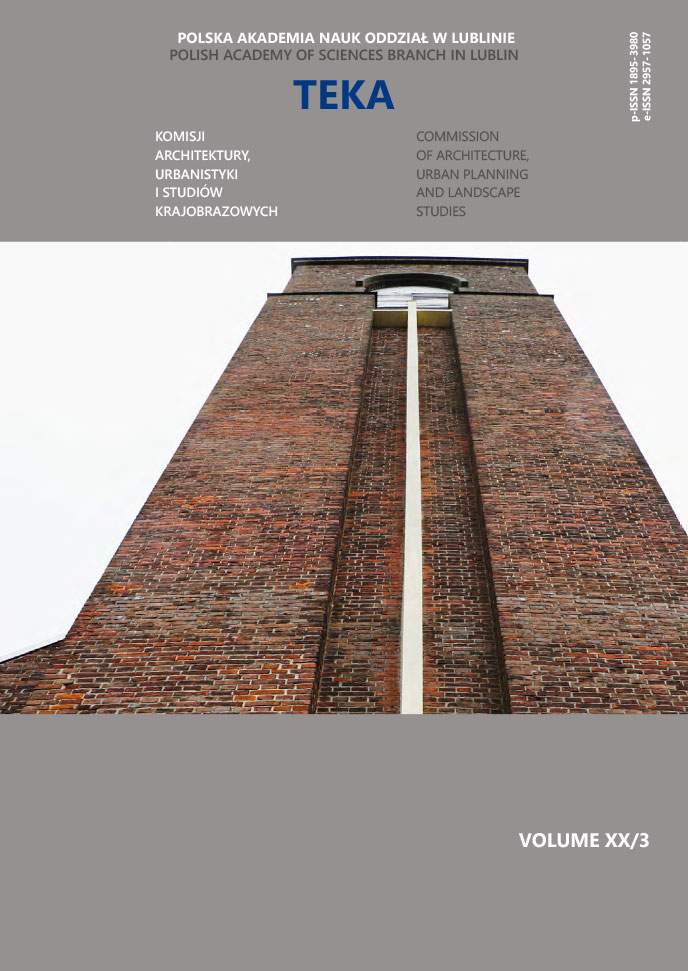The Tatary district as the first modern multidwelling residential estate in Lublin
Urban development concepts and architectural solutions
Michał Dmitruk
m.dmitruk@pollub.plFaculty of Civil Engineering and Architecture, Department of Architecture, Urban and Spatial Planning, Lublin University of Technology (Polska)
https://orcid.org/0000-0002-6368-4206
Abstrakt
The Tatary district is located in the central-east part of Lublin. It includes the first Lublin’s multi-dwelling residential estate neighbouring buzzing streets and large industrial facilities, built according to modern architectural and urban concepts. The residential estate, erected starting in the 1950’, served as a model for subsequent large residential estates of Lublin. The technical solutions introduced in the Tatary buildings translated into a new standard of living and functional solutions that were unique within the traditional city tissue, shaping it permanently. After almost 60 years, the estate is facing a number of problems due to political, planning and architectural decisions. This article aims at describing and evaluating these past solutions.
Instytucje finansujące
Słowa kluczowe:
housing estate, urban planning, multi-dwelling, workers' housing estate, residential building, Polish People's RepublicBibliografia
Androsiuk J., 1965. Tatary and Kalinowszczyzna housing estates in Lublin [Osiedla Tatary i Kalinowszczyzna Lublinie], Architektura 10/215.
Google Scholar
Dmitruk M., Parking problems in residential districts based on Lublin [Problemy parkowania w dzielnicach mieszkaniowych na przykładzie Lublina], [in:] Nowe idee w rozwiązywaniu problemów komunikacyjnych miast, Lublin 2018.
Google Scholar
Gawarecki H., Gawdzik C., Lublin. Landscape and Architecture [Lublin. Krajobraz i Architektura], Arkady, Warsaw 1964.
Google Scholar
Gawrecki H., Gawdzik C., Along the streets of Lublin [Ulicami Lublina], Wydawnictwo lubelskie, Lublin 1976.
Google Scholar
Jezierski A. A., Economic history of Poland [Historia gospodarcza Polski]: 1815−1980, Wydawnictwa Uniwersytetu Warszawskiego, Warsaw 1987.
Google Scholar
Kierk A., ed., The history of Lubelszczyzna [Dzieje Lubelszczyzny], Vol. II, Warsaw, 1979. W. Korzeniewski, Urban and residential standard [Normatyw urbanistyczny i mieszkaniowy] – 1974, Warsaw 1980.
Google Scholar
Mumford E., The CIAM Discourse on Urbanism, 1928−1960. The MIT Press,Cambridge MA, 2000.
Google Scholar
Przesmycka E., Sosnowska M., The condition of public zones in residential estates of 1950’ based on Lublin [Stan zachowania przestrzeni publicznych osiedli mieszkaniowych z lat 50. XX w. na przykładzie Lublina], [in:] Teka Komisji Architektury Urbanistyki i Studiów Krajobrazowych, OLPAN, 2010.
Google Scholar
Syrkus H., Towards the idea of a social housing estate [Ku idei osiedla społecznego]: 1925−1975, Państwowe Wydawnictwo Naukowe, Warsaw 1976.
Google Scholar
Journal of Laws from 1950, No. 37, item 344.
Google Scholar
Polish Council of Ministers Resolution No. 364 of 20 August 1959 accepting the standard for residential building [Uchwała nr 364 Rady Ministrów z 20 sierpnia 1959 r. w sprawie zatwierdzenia normatywów projektowania dla budownictwa mieszkaniowego], “Monitor Polski” 1959, no. 81, item 422.
Google Scholar
Demographic data [Dane demograficzne], Lublin City Office Public Information Bulletin [BIP Urząd Miasta Lublin]. Date of access: 01.04.2019.
Google Scholar
Michałowski S., Tatary: The state of emergency [Tatary – Stan najwyższej konieczności], http://idiks.org/tatary-stan-wyzszej-koniecznosci/. Date of access: 06.04.2019.
Google Scholar
Lublin Urban Planning Office of 1955−2005 [Lubelska Pracownia Urbanistyczna 1955−2005], Lublin City Office [Urząd Miasta Lublina], Department of Strategic Planning and Development [Wydział Strategii i Rozwoju], Lublin 2005.
Google Scholar
Autorzy
Michał Dmitrukm.dmitruk@pollub.pl
Faculty of Civil Engineering and Architecture, Department of Architecture, Urban and Spatial Planning, Lublin University of Technology Polska
https://orcid.org/0000-0002-6368-4206
Statystyki
Abstract views: 213PDF downloads: 191




